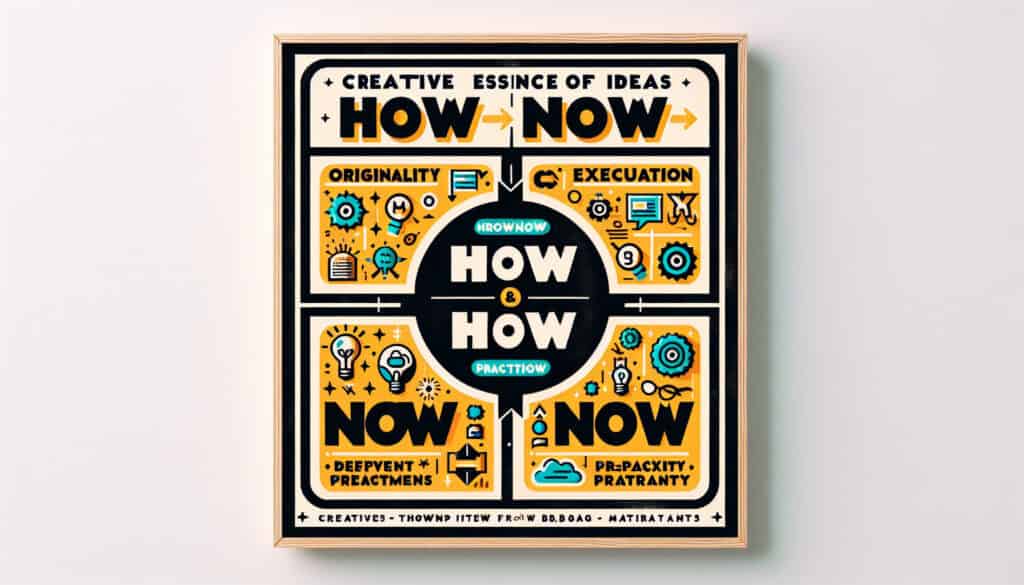To categorize and prioritize ideas based on their originality and feasibility.
- Methodologies: Lean Sigma, Manufacturing
How-Now-Wow Matrix

How-Now-Wow Matrix
- Agile Methodology, Brainstorming, Creativity, Design Thinking, Ideation, Innovation, Project Management, Prototyping, User-Centered Design
Objective:
How it’s used:
- A 2x2 matrix used to evaluate ideas based on two criteria: feasibility (how easy it is to implement) and originality (how innovative it is). Ideas are plotted on the matrix as 'How' (innovative but not feasible), 'Now' (easy to implement but not original), or 'Wow' (both innovative and feasible).
Pros
- Simple and easy to understand; Helps to prioritize ideas and focus on the most promising ones.
Cons
- Can be subjective and depend on the criteria used; May stifle creativity by focusing too much on feasibility.
Categories:
- Ideation, Project Management
Best for:
- Prioritizing ideas in a brainstorming session to identify those that are both innovative and actionable.
The How-Now-Wow Matrix serves as an effective tool in various settings such as workshops, product development phases, and innovation sessions across industries like consumer electronics, automotive, healthcare, and software development. Its practicality shines in early-stage brainstorming sessions, enabling teams to visualize and categorize ideas efficiently, thus avoiding lengthy debates on each concept. Typically, project stakeholders, including designers, engineers, marketing teams, and management, gather to contribute and assess ideas collaboratively. By using the matrix, teams can quickly identify which ideas fall into the ‘Wow’ category, which combine high feasibility with strong innovation, allowing them to prioritize these ideas for further exploration and development. This not only accelerates the decision-making process but also fosters a culture of innovation, as team members can see where their creative thoughts fit within the broader scope of the project. Various applications include developing new product features, solving engineering challenges, enhancing service delivery methods, and even mapping out marketing strategies. The method’s straightforward, visual approach facilitates discussions, encourages participation, and contributes to the alignment of the team’s goals, making it a favored choice for organizations eager to innovate within budget and time constraints.
Key steps of this methodology
- Generate a list of ideas through brainstorming.
- Evaluate each idea for feasibility by assessing required resources and potential obstacles.
- Evaluate each idea for originality considering its innovative qualities and uniqueness.
- Plot each idea on the 2x2 matrix according to its feasibility and originality ratings.
- Identify ideas in the 'Wow' quadrant as top priorities for development.
- Select ideas from 'Now' for immediate implementation.
- Consider 'How' ideas for potential future development with further investigation.
- Discern if any 'Wow' concepts can be made more feasible through adaptation.
Pro Tips
- Involve cross-disciplinary teams to enrich the discussion and generate diverse viewpoints, ensuring a broader range of innovative ideas.
- Use a scoring system to quantify feasibility and originality, allowing for more objective placement of ideas on the matrix. <li Regularly revisit and update ideas based on new data or changing contexts, keeping the matrix relevant to evolving industry standards.
To read and compare several methodologies, we recommend the
> Extensive Methodologies Repository <
together with the 400+ other methodologies.
Your comments on this methodology or additional info are welcome on the comment section below ↓ , so as any engineering-related ideas or links.
Historical Context
1949
1950
1950
1960
1960
1960
1960
1940
1950
1950
1958
1960
1960
1960
1960
(if date is unknown or not relevant, e.g. "fluid mechanics", a rounded estimation of its notable emergence is provided)















Related Posts
METS to Calories Calculator
Meta-Analysis
Message Mapping
Mental Model Diagrams
Maximum Acceptable Pushing and Pulling Forces
Material Requirements Planning (MRP)